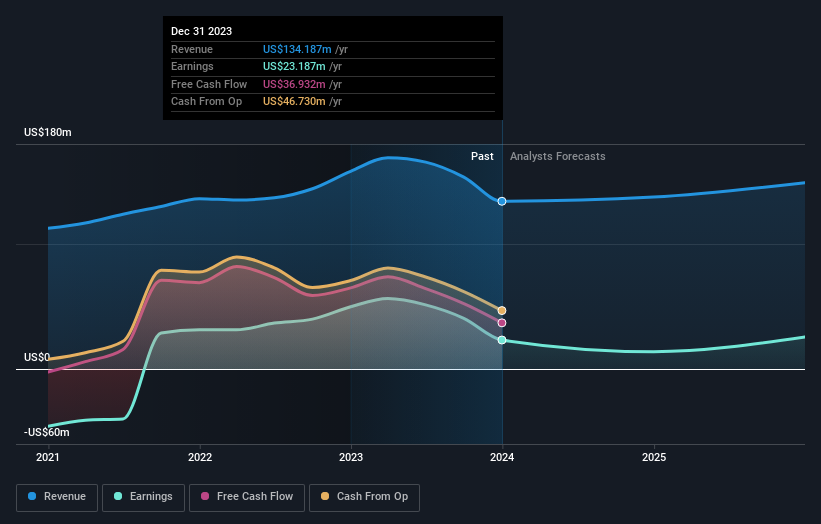key insights
-
Significant ownership of Carter Bank stock by retail investors indicates that they collectively have a greater say in management and business strategy
-
Top 25 shareholders own 40% of the company
-
Institutional ownership of Carter Bank stock is 42%
If you want to know who really controls Carter Bankshares, Inc. (NASDAQ:CARE), you'll have to take a look at the makeup of its share registry. We can see that retail investors hold the majority, accounting for 54% of the company's shares. That is, if the stock price rises, the group will gain the most (or if the stock price falls, it will suffer the maximum loss).
Meanwhile, institutional investors have an ownership of 42% in the company. Insiders often own a lot of younger, smaller companies, while huge companies tend to have institutions as shareholders.
Let's take a closer look to see what the different types of shareholders can tell us about Carter Bank stock.
See our latest analysis for Carter Bank Stock.


What does institutional ownership tell us about Carter Bank Stock?
Institutions typically measure a stock against a benchmark when reporting to their own investors, so enthusiasm for a stock often increases once it's included in a major index. We would expect most companies to have some institutions on their register, especially if they are growing.
As you can see, institutional investors have a fair amount of stake in Carter Bank stock. This may indicate that the company has some credibility in the investment community. However, it is best to be wary of relying on the supposed validation that comes with institutional investors. They also sometimes make mistakes. If multiple financial institutions change their view on a stock at the same time, you could see the stock price drop fast. It is therefore worth checking Carter Bankshares's earnings history, below. Of course, what really matters is the future.


Note that hedge funds don't have a meaningful investment in Carter Bank stock. The company's largest shareholder is BlackRock, Inc., with ownership of 7.5%. Meanwhile, the second and third largest shareholders hold 5.9% and 5.3% of the shares outstanding, respectively.
Our research shows that the top 25 shareholders collectively control less than half of the company's shares. This means that the company's shares are widely distributed and there is no dominant shareholder.
While it makes sense to study institutional ownership data for a company, it also makes sense to study analyst sentiments to know which way the wind is blowing. There are a significant number of analysts covering this stock, so it might be useful to know their aggregate forecast for the future.
Insider ownership of Carter Bank stock
The precise definition of an insider can be subjective, but almost everyone considers board members to be insiders. The answers of company management to the board of directors and the latter must represent the interests of shareholders. In particular, top-level managers may serve on the board themselves.
I generally consider insider ownership to be a good thing. However, in some cases, it may be more difficult for other shareholders to be held accountable for board decisions.
We can report that insiders own shares in Carter Bancshares. The company's market capitalization is just US$263m, but insiders have US$10m worth of shares in their own names. Some might say this shows alignment of interests between shareholders and the board. But it might be worth checking if these insiders are selling.
Open to the public
The general public, who are usually retail investors, own 54% of Carter Bank stock, suggesting that it is a fairly popular stock. With this level of ownership, individual investors can collectively play a role in decisions that affect shareholder returns, such as dividend policy and the appointment of directors. They also have the power to vote on acquisitions and mergers that may not improve profitability.
Next steps:
It's always worth thinking about the different groups who own shares in a company. But to understand Carter Bank stock better, you need to consider many other factors. For example, consider risk.Every company has them and we discovered that 1 warning sign for Carter Bank Stock. you should know about.
If you want to know what analysts are predicting in terms of future growth, don't miss this free Report on analyst forecasts.
Note: The numbers in this article are calculated using data from the previous 12 months and refer to the 12-month period ending on the last day of the month in which the financial statements are dated. This may not match the full year annual report figures.
Have feedback on this article? Curious about its content? contact Please contact us directly. Alternatively, email our editorial team at Simplywallst.com.
This article by Simply Wall St is general in nature. We provide commentary using only unbiased methodologies, based on historical data and analyst forecasts, and articles are not intended to be financial advice. This is not a recommendation to buy or sell any stock, and does not take into account your objectives or financial situation. We aim to provide long-term, focused analysis based on fundamental data. Note that our analysis may not factor in the latest announcements or qualitative material from price-sensitive companies. Simply Wall St has no position in any stocks mentioned.

